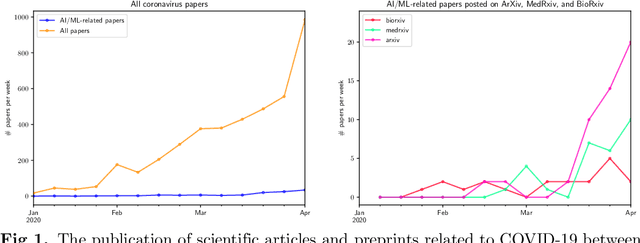Joseph Bullock
Considerations, Good Practices, Risks and Pitfalls in Developing AI Solutions Against COVID-19
Aug 13, 2020
Abstract:The COVID-19 pandemic has been a major challenge to humanity, with 12.7 million confirmed cases as of July 13th, 2020 [1]. In previous work, we described how Artificial Intelligence can be used to tackle the pandemic with applications at the molecular, clinical, and societal scales [2]. In the present follow-up article, we review these three research directions, and assess the level of maturity and feasibility of the approaches used, as well as their potential for operationalization. We also summarize some commonly encountered risks and practical pitfalls, as well as guidelines and best practices for formulating and deploying AI applications at different scales.
* 4 pages, 1 figure
Mapping the Landscape of Artificial Intelligence Applications against COVID-19
Apr 23, 2020
Abstract:COVID-19, the disease caused by the SARS-CoV-2 virus, has been declared a pandemic by the World Health Organization, with over 2.5 million confirmed cases as of April 23, 2020. In this review, we present an overview of recent studies using Machine Learning and, more broadly, Artificial Intelligence, to tackle many aspects of the COVID-19 crisis at different scales including molecular, clinical, and societal applications. We also review datasets, tools, and resources needed to facilitate AI research. Finally, we discuss strategic considerations related to the operational implementation of projects, multidisciplinary partnerships, and open science. We highlight the need for international cooperation to maximize the potential of AI in this and future pandemics.
PulseSatellite: A tool using human-AI feedback loops for satellite image analysis in humanitarian contexts
Jan 29, 2020

Abstract:Humanitarian response to natural disasters and conflicts can be assisted by satellite image analysis. In a humanitarian context, very specific satellite image analysis tasks must be done accurately and in a timely manner to provide operational support. We present PulseSatellite, a collaborative satellite image analysis tool which leverages neural network models that can be retrained on-the fly and adapted to specific humanitarian contexts and geographies. We present two case studies, in mapping shelters and floods respectively, that illustrate the capabilities of PulseSatellite.
* 2 pages, 2 figures
Automated Speech Generation from UN General Assembly Statements: Mapping Risks in AI Generated Texts
Jun 05, 2019Abstract:Automated text generation has been applied broadly in many domains such as marketing and robotics, and used to create chatbots, product reviews and write poetry. The ability to synthesize text, however, presents many potential risks, while access to the technology required to build generative models is becoming increasingly easy. This work is aligned with the efforts of the United Nations and other civil society organisations to highlight potential political and societal risks arising through the malicious use of text generation software, and their potential impact on human rights. As a case study, we present the findings of an experiment to generate remarks in the style of political leaders by fine-tuning a pretrained AWD- LSTM model on a dataset of speeches made at the UN General Assembly. This work highlights the ease with which this can be accomplished, as well as the threats of combining these techniques with other technologies.
* 5 pages
XNet: A convolutional neural network (CNN) implementation for medical X-Ray image segmentation suitable for small datasets
Dec 03, 2018Abstract:X-Ray image enhancement, along with many other medical image processing applications, requires the segmentation of images into bone, soft tissue, and open beam regions. We apply a machine learning approach to this problem, presenting an end-to-end solution which results in robust and efficient inference. Since medical institutions frequently do not have the resources to process and label the large quantity of X-Ray images usually needed for neural network training, we design an end-to-end solution for small datasets, while achieving state-of-the-art results. Our implementation produces an overall accuracy of 92%, F1 score of 0.92, and an AUC of 0.98, surpassing classical image processing techniques, such as clustering and entropy based methods, while improving upon the output of existing neural networks used for segmentation in non-medical contexts. The code used for this project is available online.
 Add to Chrome
Add to Chrome Add to Firefox
Add to Firefox Add to Edge
Add to Edge